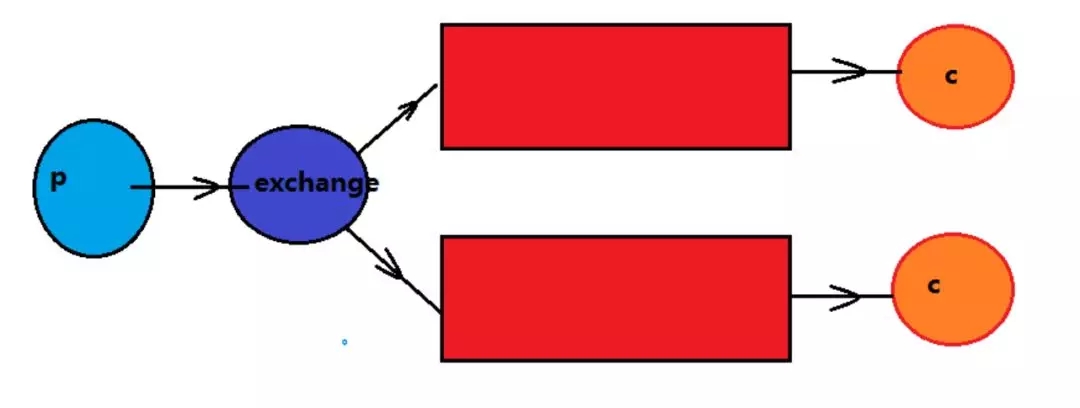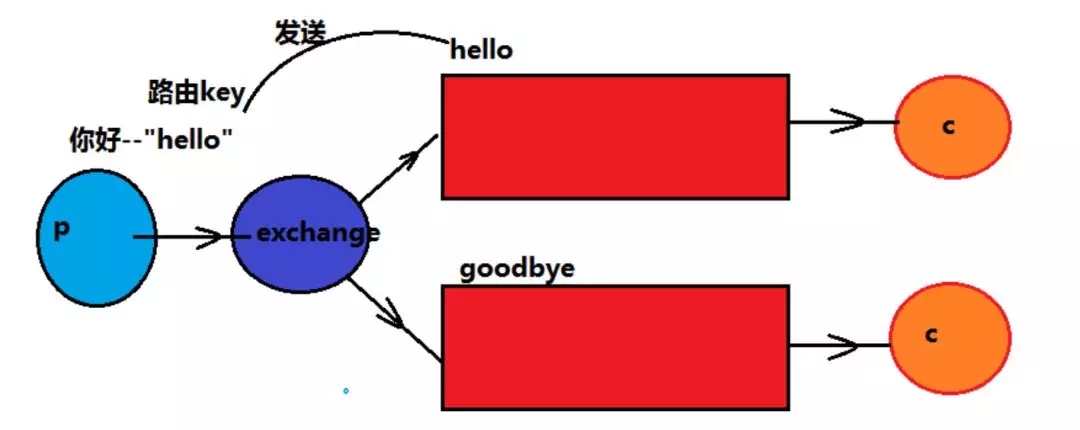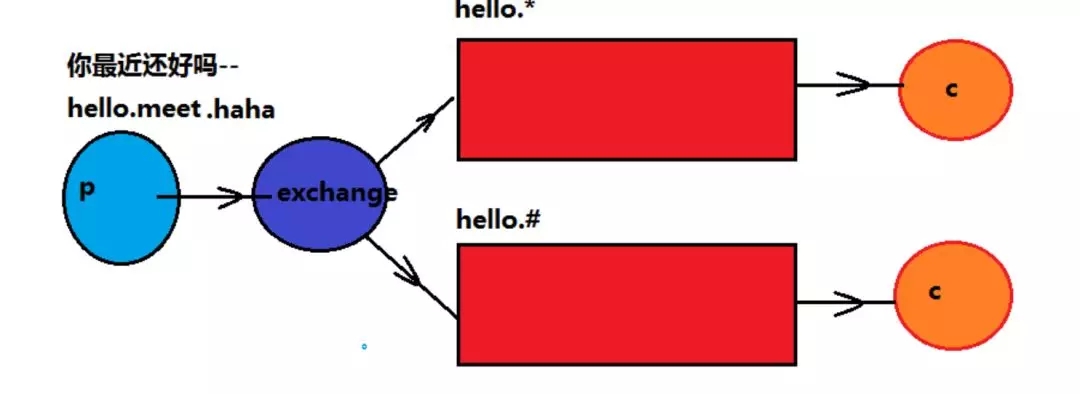rabbitMQ模式

消费者监听队列,如果队列中有消息,就消费掉,消息被拿走后,自动从队列删除
(隐患,消息可能没有被消费者正确处理,已经消失了,无法恢复)
应用场景:聊天室
案例:
1>.首先准备依赖
<dependency>
<groupId>org.springframework.boot</groupId>
<artifactId>spring-boot-starter-amqp</artifactId>
</dependency>2>.写一个test类
public class SimpleTest {
//模拟生产者将消息放入队列
@Test
public void send() throws Exception{
/*1 创建连接工厂
* 2 配置共创config
* 3 获取连接
* 4获取信道
* 5 从信道声明queue
* 6 发送消息
* 7 释放资源
*/
ConnectionFactory factory=new ConnectionFactory();
factory.setHost("106.23.34.56");
factory.setPort(5672);
factory.setVirtualHost("/tb");
factory.setUsername("admin");
factory.setPassword("123456");
//从工厂获取连接
Connection conn=factory.newConnection();
//从连接获取信道
Channel chan=conn.createChannel();
//利用channel声明第一个队列
chan.queueDeclare("simple", false, false, false, null);
//queue String类型,表示声明的queue对列的名字
//durable Boolean类型,表示是否持久化
//exclusive Boolean类型:当前声明的queue是否专注;true当前连接创建的
//任何channle都可以连接这个queue,false,新的channel不可使用
//autoDelete Boolean类型:在最后连接使用完成后,是否删除队列,false
//arguments Map类型,其他声明参数
//发送消息
String msg="helloworld,nihaoa";
chan.basicPublish("", "simple", null, msg.getBytes());
//exchange String类型,交换机名称,简单模式使用默认交换""
//routingkey String类型,当前的消息绑定的routingkey,简单模式下,与队列同名即可
//props BasicProperties类型,消息的属性字段对象,例如BasicProperties
//可以设置一个deliveryMode的值0 持久化,1 表示不持久化,durable配合使用
//body byte[] :消息字符串的byte数组
}
//模拟消费端
@Test
public void receive() throws Exception{ConnectionFactory factory=new ConnectionFactory();
factory.setHost("106.23.34.56");
factory.setPort(5672);
factory.setVirtualHost("/tb");
factory.setUsername("admin");
factory.setPassword("123456");
//从工厂获取连接Connection conn=factory.newConnection();//从连接获取信道Channel chan=conn.createChannel();chan.queueDeclare("simple", false, false, false, null);//创建一个消费者QueueingConsumer consumer= new QueueingConsumer(chan);chan.basicConsume("simple", consumer);//监听队列while(true){//获取下一个delivery,delivery从队列获取消息Delivery delivery = consumer.nextDelivery();String msg=new String(delivery.getBody());System.out.println(msg);}}}
2.work模式
生产者将消息放入队列
多个消费者同时监听同一个队列,消息如何被消费?
C1,C2共同争抢当前消息队列的内容,谁先拿到消息,谁来负责消费
应用场景:红包;大型项目中的资源调度过程(直接由最空闲的系统争抢到资源处理任务)
案例:
1>首先写一个工具类
public class ConnectionUtil {
public static Connection getConn(){
try{
ConnectionFactory factory=new ConnectionFactory();
factory.setHost("106.33.44.179");
factory.setPort(5672);
factory.setVirtualHost("/tb");
factory.setUsername("admin");
factory.setPassword("123456");
//从工厂获取连接
Connection conn=factory.newConnection();
return conn;
}catch(Exception e){
System.out.println(e.getMessage());
return null;
}
}
}2>写test类
public class WorkTest {
@Test
public void send() throws Exception{
//获取连接
Connection conn = ConnectionUtil.getConn();
Channel chan = conn.createChannel();
//声明队列
chan.queueDeclare("work", false, false, false, null);
for(int i=0;i<100;i++){
String msg="1712,hello:"+i+"message";
chan.basicPublish("", "work", null, msg.getBytes());
System.out.println("第"+i+"条信息已经发送");
}
chan.close();
conn.close();
}
@Test
public void receive1() throws Exception{
//获取连接,获取信道
Connection conn = ConnectionUtil.getConn();
Channel chan = conn.createChannel();
chan.queueDeclare("work", false, false, false, null);
//同一时刻服务器只发送一条消息给同一消费者,消费者空闲,才发送一条
chan.basicQos(1);
//定义消费者
QueueingConsumer consumer=new QueueingConsumer(chan);
//绑定队列和消费者的关系
//queue
//autoAck:消息被消费后,是否自动确认回执,如果false,不自动需要手动在
//完成消息消费后进行回执确认,channel.ack,channel.nack
//callback
//chan.basicConsume(queue, autoAck, callback)
chan.basicConsume("work", false, consumer);
//监听
while(true){
Delivery delivery=consumer.nextDelivery();
byte[] result = delivery.getBody();
String msg=new String(result);
System.out.println("接受到:"+msg);
Thread.sleep(50);
//返回服务器,回执
chan.basicAck(delivery.getEnvelope().getDeliveryTag(), false);
}
}
@Test
public void receive2() throws Exception{
//获取连接,获取信道
Connection conn = ConnectionUtil.getConn();
Channel chan = conn.createChannel();
chan.queueDeclare("work", false, false, false, null);
//同一时刻服务器只发送一条消息给同一消费者,消费者空闲,才发送一条
chan.basicQos(1);
//定义消费者
QueueingConsumer consumer=new QueueingConsumer(chan);
//绑定队列和消费者的关系
//queue
//autoAck:消息被消费后,是否自动确认回执,如果false,不自动需要手动在
//完成消息消费后进行回执确认,channel.ack,channel.nack
//callback
//chan.basicConsume(queue, autoAck, callback)
chan.basicConsume("work", false, consumer);
//监听
while(true){
Delivery delivery=consumer.nextDelivery();
byte[] result = delivery.getBody();
String msg=new String(result);
System.out.println("接受到:"+msg);
Thread.sleep(150);
//返回服务器,回执
chan.basicAck(delivery.getEnvelope().getDeliveryTag(), false);
}
}
}3 publish/fanout发布订阅
生产者将消息交给交换机
有交换机根据发布订阅的模式设定将消息同步到所有的绑定队列中;
后端的消费者都能拿到消息
应用场景:邮件群发,群聊天,广告
案例:
public class FanoutTest {
//交换机,有类型,发布订阅:fanout
//路由模式:direct
//主题模式:topic
@Test
public void send() throws Exception {
//获取连接
Connection conn = ConnectionUtil.getConn();
Channel chan = conn.createChannel();
//声明交换机
//参数意义,1 交换机名称,2 类型:fanout,direct,topic
chan.exchangeDeclare("fanoutEx", "fanout");
//发送消息
for(int i=0;i<100;i++){
String msg="1712 hello:"+i+"msg";
chan.basicPublish("fanoutEx", "", null, msg.getBytes());
System.out.println("第"+i+"条信息已经发送");
}
}
@Test
public void receiv01() throws Exception{
//获取连接
Connection conn = ConnectionUtil.getConn();
Channel chan = conn.createChannel();
//生命队列
chan.queueDeclare("fanout01", false, false, false, null);
//声明交换机
chan.exchangeDeclare("fanoutEx", "fanout");
//绑定队列到交换机
//参数 1 队列名称,2 交换机名称 3 路由key
chan.queueBind("fanout01", "fanoutEx", "");
chan.basicQos(1);
//定义消费者
QueueingConsumer consumer=new QueueingConsumer(chan);
//消费者与队列绑定
chan.basicConsume("fanout01",false, consumer);
while(true){
Delivery delivery= consumer.nextDelivery();
System.out.println("一号消费者接收到"+
new String(delivery.getBody()));
chan.basicAck(delivery.getEnvelope().
getDeliveryTag(), false);
}
}
@Test
public void receiv02() throws Exception{
//获取连接
Connection conn = ConnectionUtil.getConn();
Channel chan = conn.createChannel();
//生命队列
chan.queueDeclare("fanout02", false, false, false, null);
//声明交换机
chan.exchangeDeclare("fanoutEx", "fanout");
//绑定队列到交换机
//参数 1 队列名称,2 交换机名称 3 路由key
chan.queueBind("fanout02", "fanoutEx", "");
chan.basicQos(1);
//定义消费者
QueueingConsumer consumer=new QueueingConsumer(chan);
//消费者与队列绑定
chan.basicConsume("fanout02",false, consumer);
while(true){
Delivery delivery= consumer.nextDelivery();
System.out.println("二号消费者接收到"+new String(delivery.getBody()));
chan.basicAck(delivery.getEnvelope().getDeliveryTag(), false);
}
}
}4 routing路由模式
生产者发送消息到交换机,同时绑定一个路由Key,交换机根据路由key对下游绑定的队列进行路
由key的判断,满足路由key的队列才会接收到消息,消费者消费消息
应用场景: 项目中的error报错
案例:
public class RoutingTopicTest {
@Test
public void routingSend() throws Exception{
//获取连接
Connection conn = ConnectionUtil.getConn();
Channel chan = conn.createChannel();
//声明交换机
//参数意义,1 交换机名称,2 类型:fanout,direct,topic
chan.exchangeDeclare("directEx", "direct");
//发送消息
String msg="路由模式的消息";
chan.basicPublish("directEx", "jt1713",
null, msg.getBytes());
}
@Test
public void routingRec01() throws Exception{
System.out.println("一号消费者等待接收消息");
//获取连接
Connection conn = ConnectionUtil.getConn();
Channel chan = conn.createChannel();
//声明队列
chan.queueDeclare("direct01", false, false, false, null);
//声明交换机
chan.exchangeDeclare("directEx", "direct");
//绑定队列到交换机
//参数 1 队列名称,2 交换机名称 3 路由key
chan.queueBind("direct01", "directEx", "jt1712");
chan.basicQos(1);
//定义消费者
QueueingConsumer consumer=new QueueingConsumer(chan);
//消费者与队列绑定
chan.basicConsume("direct01",false, consumer);
while(true){
Delivery delivery= consumer.nextDelivery();
System.out.println("一号消费者接收到"+
new String(delivery.getBody()));
chan.basicAck(delivery.getEnvelope().
getDeliveryTag(), false);
}
}
@Test
public void routingRec02() throws Exception{
System.out.println("二号消费者等待接收消息");
//获取连接
Connection conn = ConnectionUtil.getConn();
Channel chan = conn.createChannel();
//声明队列
chan.queueDeclare("direct02", false, false, false, null);
//声明交换机
chan.exchangeDeclare("directEx", "direct");
//绑定队列到交换机
//参数 1 队列名称,2 交换机名称 3 路由key
chan.queueBind("direct02", "directEx", "jt1711");
chan.basicQos(1);
//定义消费者
QueueingConsumer consumer=new QueueingConsumer(chan);
//消费者与队列绑定
chan.basicConsume("direct02",false, consumer);
while(true){
Delivery delivery= consumer.nextDelivery();
System.out.println("二号消费者接收到"+
new String(delivery.getBody()));
chan.basicAck(delivery.getEnvelope().
getDeliveryTag(), false);
}
}
}5 topic主题模式
*号代表单个词语
#代表多个词语
其他的内容与routing路由模式一致
案例:
public class RoutingTopicTest {
@Test
public void routingRec02() throws Exception{
System.out.println("二号消费者等待接收消息");
//获取连接
Connection conn = ConnectionUtil.getConn();
Channel chan = conn.createChannel();
//声明队列
chan.queueDeclare("direct02", false, false, false, null);
//声明交换机
chan.exchangeDeclare("directEx", "direct");
//绑定队列到交换机
//参数 1 队列名称,2 交换机名称 3 路由key
chan.queueBind("direct02", "directEx", "jt1711");
chan.basicQos(1);
//定义消费者
QueueingConsumer consumer=new QueueingConsumer(chan);
//消费者与队列绑定
chan.basicConsume("direct02",false, consumer);
while(true){
Delivery delivery= consumer.nextDelivery();
System.out.println("二号消费者接收到"+
new String(delivery.getBody()));
chan.basicAck(delivery.getEnvelope().
getDeliveryTag(), false);
}
}
@Test
public void topicSend() throws Exception{
//获取连接
Connection conn = ConnectionUtil.getConn();
Channel chan = conn.createChannel();
//声明交换机
//参数意义,1 交换机名称,2 类型:fanout,direct,topic
chan.exchangeDeclare("topicEx", "topic");
//发送消息
String msg="主题模式的消息";
chan.basicPublish("topicEx", "jt1712.add.update",
null, msg.getBytes());
}
@Test
public void topicRec01() throws Exception{
System.out.println("一号消费者等待接收消息");
//获取连接
Connection conn = ConnectionUtil.getConn();
Channel chan = conn.createChannel();
//声明队列
chan.queueDeclare("topic01", false, false, false, null);
//声明交换机
chan.exchangeDeclare("topicEx", "topic");
//绑定队列到交换机
//参数 1 队列名称,2 交换机名称 3 路由key
chan.queueBind("topic01", "topicEx", "jt1712");
chan.basicQos(1);
//定义消费者
QueueingConsumer consumer=new QueueingConsumer(chan);
//消费者与队列绑定
chan.basicConsume("topic01",false, consumer);
while(true){
Delivery delivery= consumer.nextDelivery();
System.out.println("一号消费者接收到"+
new String(delivery.getBody()));
chan.basicAck(delivery.getEnvelope().
getDeliveryTag(), false);
}
}
@Test
public void topicRec02() throws Exception{
System.out.println("二号消费者等待接收消息");
//获取连接
Connection conn = ConnectionUtil.getConn();
Channel chan = conn.createChannel();
//声明队列
chan.queueDeclare("topic02", false, false, false, null);
//声明交换机
chan.exchangeDeclare("topicEx", "topic");
//绑定队列到交换机
//参数 1 队列名称,2 交换机名称 3 路由key
chan.queueBind("topic02", "topicEx", "jt1712.#");
chan.basicQos(1);
//定义消费者
QueueingConsumer consumer=new QueueingConsumer(chan);
//消费者与队列绑定
chan.basicConsume("topic02",false, consumer);
while(true){
Delivery delivery= consumer.nextDelivery();
System.out.println("二号消费者接收到"+
new String(delivery.getBody()));
chan.basicAck(delivery.getEnvelope().
getDeliveryTag(), false);
}
}
}rabbitMQ模式的更多相关文章
- RabbitMQ入门-Topic模式
上篇<RabbitMQ入门-Routing直连模式>我们介绍了可以定向发送消息,并可以根据自定义规则派发消息.看起来,这个Routing模式已经算灵活的了,但是,这还不够,我们还有更加多样 ...
- RabbitMQ基本操作
更加详细的 链接https://www.cnblogs.com/dwlsxj/p/RabbitMQ.html RabbitMQ基础知识 一.背景 RabbitMQ是一个由erlang开发的AMQP(A ...
- 队列模式&主题模式
# RabbitMQ 消息中间件 **Advanced Message Queuing Protocol (高级消息队列协议** The Advanced Message Queuing Protoc ...
- RabbitMQ图解
一.MQ对比 二.RabbitMQ模式 三.队列模式 四.公平分发 五.主题模式
- RabbitMQ之集群搭建
1.RabbitMQ集群模式RabbitMQ集群中节点包括内存节点(RAM).磁盘节点(Disk,消息持久化),集群中至少有一个Disk节点. 2.普通模式(默认) 对于普通模式,集群中 ...
- 28、springboot整合RabbitMQ(2)
1.监听 1.1.监听队列 如订单系统和库存系统 订单系统下订单之后将消息存放在消息队列中 库存系统需要时刻进行监听消息队列的内容,有新的订单就需要进行库存相关的操作 此时模拟监听消息队列中的Bo ...
- SpringBoot与消息(RabbitMQ)
1. JMS和AMQP JMS(Java Message Service): ActiveMQ是JMS实现; AMQP(Advanced Message Queuing Protocol) 兼容JMS ...
- CentOS7安装rabbitmq集群(二进制)
一.RabbiMQ简介 RabbiMQ是用Erang开发的,集群非常方便,因为Erlang天生就是一门分布式语言,但其本身并不支持负载均衡. RabbiMQ模式 RabbitMQ模式大概分为以下三种: ...
- Java RabbitMQ配置和使用,基于SpringBoot
package rabbitmq.demo; import com.rabbitmq.client.AMQP; import org.junit.Test; import org.junit.runn ...
随机推荐
- Angular2入门:TypeScript的类 - 参数属性:定义和初始化类成员
- vim之添加多行和删除多行
1.复制单行和多行. 1)单行复制 在命令模式下,将光标移到将要复制的行处,按“yy”进行复制,按“p”进行粘贴. 2)多行复制 在命令模式下,将光标移到将要复制的行处,按“nyy”进行复制(n代表行 ...
- 分享一个爬取HUST(哈理工)学生成绩的Python程序(OCR自动识别验证码)
Python版本:3.5.2 日期:2018/1/21 __Author__ = "Lance#" # -*- coding = utf-8 -*- from urllib imp ...
- JavaScript匿名函数入门。
1.第一种匿名函数的使用:简单的调用 var f=function(){ return 'Hello'; }; //匿名函数没法调用,只能赋值,所以作为赋值语句后面得加分号 var result= ...
- 数据库部分(MySql)_2
分组查询 分组查询通常和聚合函数结合使用,查询条件中每个XXX就以XXX为分组的条件: 格式:每个A的平均B select avg(B) from 表名 group by A; having 在whe ...
- 《Office 365开发入门指南》上市说明和读者服务
写在最开始的话 拙作<Office 365开发入门指南>上周开始已经正式在各大书店.在线商城上市,欢迎对Office 365的开发.生态感兴趣的开发者.项目经理.产品经理参考本书,全面了解 ...
- Tomcat服务器为java项目配置顶级域名
修改端口, Tomcat服务器下conf/server.xml文件 把端口号更改为80 解释:输入域名时默认进入80端口,如果没修改则需要输入端口号才能进入. Eg:www.xxx.com: ...
- python基础学习(七)列表
列表的定义 List(列表) 是 Python 中使用 最频繁 的数据类型,在其他语言中通常叫做 数组(例如java.c) 专门用于存储 一串 信息 列表用 [] 定义,数据 之间使用 , 分隔 列表 ...
- Reinforcement Learning: An Introduction读书笔记(4)--动态规划
> 目 录 < Dynamic programming Policy Evaluation (Prediction) Policy Improvement Policy Iterat ...
- java集合框架-List集合ArrayList和LinkedList详解
List 集合源码剖析 ✅ ArrayList 底层是基于数组,(数组在内存中分配连续的内存空间)是对数组的升级,长度是动态的. 数组默认长度是10,当添加数据超越当前数组长度时,就会进行扩容,扩容长 ...




